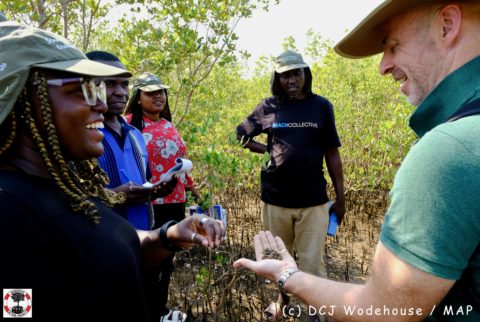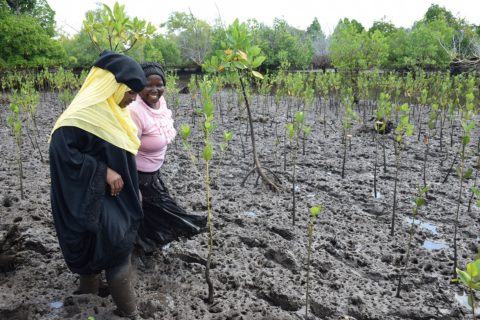Africa has 20 percent of global mangroves, with 74 percent on the west coast and 26 percent on the east coast (Naidoo, 2023). Along the east coast, mangroves are found in 15 countries, with Kenya, Tanzania and Mozambique having the largest coverage.
These salt-tolerant trees are a vital ecosystem for local communities. They are a bedrock for the biodiversity that supports local fisheries. They provide poles and timber for construction and are power stores for carbon, help to regulate climate and mitigate climate risk and act as a barrier against storm surges and coastal erosion.
These momentous benefits are, however, at risk due to human-induced pressures on Africa’s mangrove ecosystems ranging from agricultural development for rice and large-scale irrigation schemes to large infrastructural development projects such ports and dams, extractive mining and overharvesting of mangroves for timber, poles and wood fuel.
Continuous deforestation of mangroves not only leads to habitat destruction but also disturbs biodiversity. As a result, local communities whose primary source of livelihood is fishing have, in the past decade, been recording dwindling harvests along the east coast. In addition, coastal resilience against storms and climate change impacts has reduced, exposing coastal communities to property damage and physical harm.
Restoration, not just Planting
Besides concerted efforts to conserve the remaining mangrove forests, there are numerous initiatives to restore degraded areas, with studies estimating that nearly 74 percent of the mangroves lost worldwide since 1996 to be highly ‘restorable’.

Wrong species planted at wrong site
Along Africa’s east coast, as with other countries worldwide, mangrove restoration activities have as recently as 2020 focused mainly on planting. Unfortunately, studies indicate have shown that about 80 percent of global mangrove planting initiatives are prone to failure.
Husna Bakari, vice secretary for the youth-led Pate Resources and Tourism Initiative (PRATI) in Lamu, Kenya, says many mangrove restoration initiatives have been failing to bear fruit due to a lack of knowledge and skills on ecological mangrove restoration. In Lamu, for example, most restoration initiatives have focused on planting and ignored the crucial aspects of the restoration process – mainly biological, social, historical and political.
To address this challenge in the east coast of Africa, Wetlands International has, since 2019, been partnering with Mangrove Action Project to train local communities, forest managers, national and sub-national government officials, academia and research institutions, civil society and private sector on the Community-Based Ecological Mangrove Restoration (CBEMR) approach. This is aimed at building the capacity of mangrove actors on best practices using the CBEMR techniques to achieve maximum success of mangrove restoration initiatives. So far, six training workshops with field excursions have been conducted in Lamu, Kenya; Rufiji Delta and Tanga in Tanzania; and Maputo in Mozambique.

Field excursions cement knowledge gained in classroom workshops. Photo by: DCJ Wodehouse/MAP
CBEMR, unlike many planting projects, takes into account mangrove biology and ecology in addition to the socio-economical aspects that can affect restoration efforts. By so doing, it mimics natural processes such as regeneration to produce a more biodiverse mangrove forest. Active planting is only done when necessary to support natural regeneration.
Where Man and Mangroves are One
Communities in Lamu archipelago have had a long-standing history and cultural connection to mangroves. They use mangroves mainly for poles for house construction, wood fuel, and other traditional practices. Major infrastructural development in Lamu also affected mangroves. Lamu is the only one in Kenya’s coast where mangrove harvesting is permissible under strict regulation by the Kenya Forest Service (KFS). However, degradation has been occurring while restoration efforts bore minimal success in the past.
In Pate, one of Lamu’s islands, uncontrolled limestone mining resulted in degradation of a site called Chukuchu. In the past, the community used limestone as construction material for their houses. They would cut and uproot mangroves to fire the kiln to produce it. Today, the community uses cement in place of traditional limestone but natural regeneration of mangroves has been minimal.

Husna Bakari planting the right species at the degraded Chukuchu site
“Following our training, we now know the importance of assessing the salinity, hydrology and ecological conditions of a site, in addition to getting the right species to transplant in the right place in the right way at the correct time, unlike before when we would plant any seed or propagule anywhere including in the water channels.
“We have learnt that if a site has a challenge with hydrology, we correct that first to allow water flow that brings in oxygen and other nutrients while allowing for a balance in salinity and the soils to drain well. Today, we mimic what nature does,” says Bakari, who is also a CBEMR champion.
Leaning on CBEMR Champions
Poor knowledge sharing, dissemination and uptake of good practices among the mangrove actors has been a weak link in mangrove restoration. To ensure that the knowledge gained in training workshops in Lamu is shared, Wetlands International nominated eight CBEMR champions from local communities across the Lamu archipelago and two from government research institutions, namely Kenya Forestry Research Institute and Kenya Marine and Fisheries Research Institute.

Mto wa Simba site in Mkunumbi that depicts success of CBEMR approach; active planting conducted in 2023
In Mkunumbi, Lamu West, for instance, the community registered a 424-member Community Forest Association (CFA) in 2023 with support from DOB Ecology, Sida and Wetlands International. Mangroves here were heavily impacted by the 1997 El Niño deluge and floodwaters from the neighbouring inland Lake Kenyatta, which inundated the area.
“The rainfall and flooding led to changes in the salinity and other key conditions for mangroves. This hindered natural regeneration for two and half decades,” explains Rassam Mansur, the Mkunumbi CFA Secretary.
In collaboration with KFS, Wetlands International and the CBEMR champions, Mkunumbi CFA is working to reclaim the degraded areas using the CBEMR approach.
“Sharing and practicing the knowledge gained from the training on CBEMR within the PRATI group and other community members in Pate has rendered above 95 percent success rate at our restoration site. This has given us the confidence to share our experiences with fellow community members in Mkunumbi and other areas,” says Mohamed Kassim, Chair and Founder of PRATI.
Collective Effort for Mangrove Restoration
Having trained a few government officials, mainly forest managers, during the workshops heavily geared for local communities and CSOs, it was noted that building the capacity of policy makers on the CBEMR approach is crucial. This would not only increase their knowledge and have a positive bearing on restoration interventions but also help in advocating for appropriate policies for and governance of mangrove ecosystems.
In May this year, two trainings on the CBEMR approach were conducted in Kenya and Mozambique. Funded by Wetlands International and organised by The Nature Conservancy, another practical workshop was held in Faza, one of the small towns within Pate Island. The 75 trainees comprising community members and KFS officials are, by far the largest cohort trained under this restoration programme.

Field excursion for policy makers and academia during training in Maputo

Group discussions for policy makers training in Kenya. Key mangrove actors need to collaborate for effective mangrove conservation and restoration
Further south, in Maputo, Mozambique, policy makers and academia drawn from various government agencies and universities were trained under the Save Our Mangroves Now! partnership which facilitates policies, programmes and investments that regenerate mangrove ecosystems, tackle climate change and sustain livelihoods in the Western Indian Ocean (WIO) region. This followed the successful training of forest managers from KFS, relevant coast county government officials, research institutions and academia in Kenya in September 2023.
Key lessons
As these best practice interventions gain momentum in the Africa and the collective action of governments and non-state actors under The Mangrove Breakthrough initiative seek, among other objectives, to stop mangrove loss and restore half of recent losses, what have we learnt so far? Several, but we expound on three key lessons.
First, the initial results from implementation show that the CBEMR approach is effective for successful mangrove restoration. It is not only participatory but also provides a holistic view of the landscape and the restoration process because it links resource users with national conservation and law enforcement agencies, research institutions, the local government and civil society. It is also essential in informing policy decisions related to mangrove conservation and aligning with the Nationally Determined Contributions for climate change mitigation.
Secondly, women and youth play a key role in mangrove restoration and conservation activities. Men, who are mostly breadwinners, spend most of their time fishing or pursuing other livelihood or economic activities and are therefore not keen on engaging in conservation initiatives. Gender roles and social groupings are, therefore, critical when planning mangrove conservation and restoration initiatives including training.
Finally, there are bound to be multiple actors involved in restoration efforts within one ecosystem. When stakeholders collaborate and pursue on a common vision for best practices on mangroves restoration, the effectiveness of mangrove conservation and management is enhanced.
In such environments, a robust and possibly consistent monitoring and evaluation framework is critical for assessing the long-term impact of mangrove restoration efforts by tracking progress, identifying challenges and refining strategies. It also enables the mangrove actors and stakeholders to avoid duplication of efforts, identify gaps and allocate resources accordingly.

